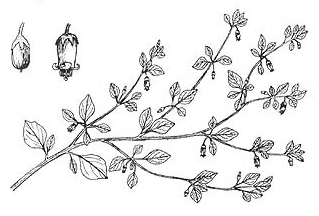Family: Solanaceae
Salpichroa origanifolia
Citation:
Baillon, Hist. Pl. 9:288 (1888).
Synonymy: Physalis origamifolia Lam., Tabl. Encycl. 2:28 (1794).
, Physalis origanifolia, Salpichroa rhomboidea Common name: Pampas lily of the valley, cocks eggs.
Description:
Scrambling perennial to several metres long, with a stout rootstock and rhizomes, older stems with a pale corky epidermis; younger parts sparsely or densely pubescent with curved simple hairs, unarmed; leaves c. 1.5-1 cm, ovate to ovate-rhombic, entire, alternate but often with a second smaller one from the axillary bud; petiole c. 0.7 cm.
Inflorescence with a solitary pendulous flower in the leaf axils; peduncle 7-10 mm long, slender; calyx tube c. 1.5 mm long, campanulate, the lobes narrowly triangular; corolla c. 7 mm long, urceolate, the lobes joined in a tube, reflexed, white or cream; filaments adnate to the tube for most of their length; anthers c. 2 mm long, sagittate below; ovary c. 2 mm long, broadly conical, glabrous, lower portion surrounded by a prominent annular fleshy disk; style c. 5 mm long, erect, pubescent in the lower half; stigma capitate and not exceeding the anthers.
Berry 13-18 x 7-8 mm, bluntly conical, succulent, aromatic, translucent when ripe, white to a pale yellowish; seeds c. 2 mm diam., discoid, hirsute if cleaned gently.

| Flowering branch, flower and fruit.
|
Image source: fig. 572C in Jessop J.P. & Toelken H.R. (Ed.) 1986. Flora of South Australia (4th edn).
|
Published illustration:
Parsons (1973) Noxious weeds of Victoria, p. 266.
|
|
Distribution:
|
S.Aust.: MU, SL, SE. All States except the N.T.
|
Conservation status:
naturalised
Flowering time: most of the year.
|

SA Distribution Map based
on current data relating to
specimens held in the
State Herbarium of South Australia
|
Biology:
This species was originally cultivated and is now naturalised in southern Australia, mostly found in urban areas and often difficult to eradicate because of its extensive root system.
Author:
Not yet available
|

